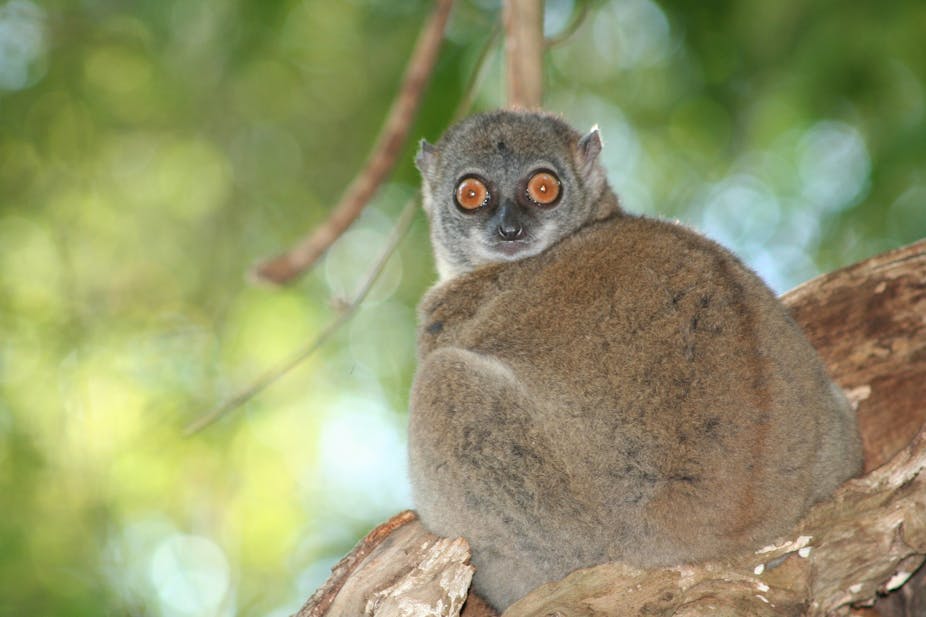While not the brightest of primates, one species of lemur has shown it can still learn a trick or two, staying safe from predators by heeding the alarm calls of other creatures in the forest.
Of all the species of lemur living on the island of Madagascar only one, Lepilemur sahamalazensis, has been found to exhibit this trait. The solitary, nocturnal creatures were found to respond to the alarm calls of the blue-eyed black lemur, and to those from several different species of bird.
A team of researchers from Bristol University, Bristol Zoo and Torino University in Italy studied the behaviour of the lepilemur, called the Sahamalaza sportive lemur because of the way it leaps between trees. Their findings have been published in the PLOS One journal.
As a solitary creature, the Sahamalaza sportive lemur doesn’t have the benefit of relying on others from its group to warn of predators. Despite being nocturnal, it must remain vigilant throughout the day to watch for potential attackers. The fossa, a kind large, wild cat, the Madagascan harrier hawk – considerably bigger than the harrier in the UK – the tree boa snake, and humans hunting for bushmeat are the main threats.
Paper author Dr Melanie Seiler, of Bristol Science Conservation Foundation, part of Bristol Zoo, spent 12 months out at the remote Ankarafa field station, set up by co-author Christoph Schwitzer and run by the Lemur Conservation Association, AEECL. The sportive lemur and the 25 other species of lepilemurs are among the most critically endangered, and were placed on the IUCN’s “red list” in 2012. “I’ve not seen more than 29 individuals in a single season,” Seiler said.
Watching the behaviour of sportive lemurs suggested a theory. “I realised that this nocturnal species is very exposed during the day and so is essentially vigilant all the time,” Seiler said. “During more than 1,000 hours of observations, we got the impression that the lemurs were quite sensitive to the vocalisations of birds, and this is what led to our experiments with alarm calls.”

In their experiments, 19 sportive lemurs were played various calls of the crested coua, the Madagascar magpie-robin, and the blue-eyed black lemur. As predicted, the sportive lemurs demonstrated a nuanced understanding of other species’ calls.
For example, the blue-eyed black lemur has a specific call for not just a threat, but an aerial threat. Played this, the sportive lemurs immediately began scanning the sky, correctly recognising that the threat would come from above. They also scanned the sky in response to the magpie-robin and coua’s alarm calls. When played the songs of the two birds or the standard call of the blue-eyed black lemur, indicating no threat, the sportive lemurs became noticeably less vigilant and more relaxed.
Marc Holderied, senior lecturer in biology at Bristol University and paper co-author, said, “It’s interesting that they understand not only the alarm, but the ‘all clear’ calls too. There’s quite a range of different meanings the lemur can glean from the calls it hears.”
Evolutionarily, it makes perfect sense that a nocturnal, solitary creature like the sportive lemur would have developed a way of staying safe during daylight hours – in this case making best use of information available on the “bush telegraph” all around it.

The sportive lemurs’ natural habitat on the Sahamalaza peninsular has suffered greatly from slash and burn agricultural practices and deforestation for plantations, leaving only 200 hectares of its home forest left. Holderied spoke of the difficulties researchers have in the face of pressure from agriculture and poaching.
“Two years ago Melanie and some other students there were fighting to put out fires in the forest, but local people were very unhappy and threats were made. The police and regional governor had to intervene to cool things down.”
On another occasion Seiler spoke to two poachers who were at a campfire before realising they were barbecuing a sportive lemur over the fire. “If it wasn’t for the station and researchers going there, this particular forest and its lemurs would be probably be gone by now,” Holderied said.
Very little is known about lepilemurs, which have only recently been defined as a family distinct from lemurs. “I hope that the results of our paper will get people more excited about these creatures, which will be essential to their conservation,” Seiler said.
“Unfortunately people don’t consider them especially beautiful or special, they don’t have blue eyes or stand out in any way,” she said. “That’s their main problem - no one is really fighting to save them. I hope with my contribution I can change that.”

